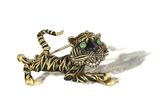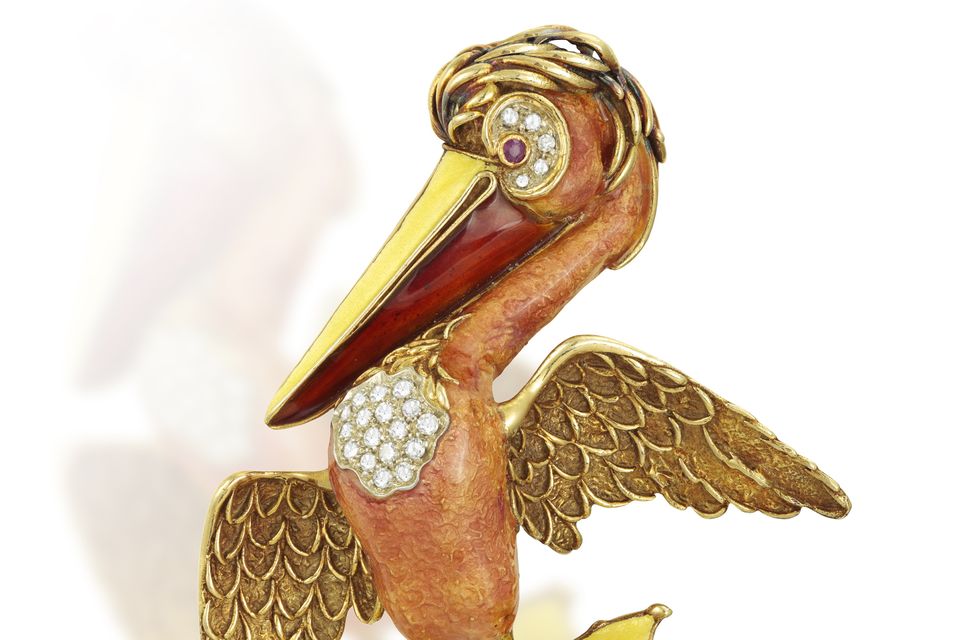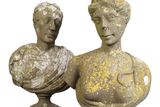Pelican brooch and rare panda pill box set to soar at auction

.jpg)

Novelty brooches are a gateway drug to hardcore designer jewellery.
The French jewellery company Van Cleef & Arpels kickstarted the trend in 1954 when they opened La Boutique, a collection of playful, accessibly priced jewellery (accessible meaning pieces that now sell for thousands, rather than tens of thousands).
These novelty brooches evolved from charms, up-scaled and made in gold with precious gemstones.
They often took the forms of animals and soon became tremendously popular with the glitterati.
The 1960s were the heyday of novelty jewellery. The American jeweller David Webb became famous for animal forms made with great skill and precious materials.
In 1964, Eugenia Sheppard, fashion editor for the New York Herald Tribune, wrote: “The list of women who own his diamond and emerald-encrusted animals reads like who’s who.
The Duchess of Windsor, Mrs Charles Wrightsman, and Mrs Amory wear his green enamel frogs.”
Pierino ‘Rino’ Frascarolo (1928-76) was the Italian master of novelty jewellery. He was known for his ‘Bestiario’, a collection of animal jewellery made in enamel and gold with intricate craftsmanship and lively, expressive designs.
There are three pieces by Frascarolo in Adam’s sale of Fine Jewellery and Watches on December 5.
Frascarolo's rare panda pill box is estimated to sell for between €4,800 to €5,200
The largest of these is a novelty brooch modelled as a pelican (Lot 48: est €4,500 to €5,500). This is a bird of great character (6.7cm long) with an orange enamelled body, textured gold plumage and yellow webbed feet.
It has a bright ruby eye and its chest is feathered with brilliant-cut diamonds.
Read more
The second piece is a panda pill box (Lot 49: est €4,800 to €5,200) with black and red enamelling, diamond eyes and beautiful golden claws. There’s a polished gold compartment inside.
The third (Lot 50: est €1,800 to €2,200) is a prowling tiger with stripes in black enamel and polished gold. All three date from around 1965.
“Most people see them as collectibles rather than wearable jewellery, although the pelican would look splendid on a jacket,” says Claire-Laurence Mestrallet of Adam’s. “The pill box is very rare — this is only the second time I’ve seen one — and you don’t often see them in such good condition.”
Enamel is very delicate. Without specialist knowledge of mid-20th century jewellery processes, it’s hard to appreciate how difficult these pieces were to make, or the level of craftsmanship that went into creating them. Frascarolo’s team combined the skills of other master craftsmen: Milanese designer and sculptor Renzo Basini; engraver Antonio Pietrolucci; and Augusto Iberti, a goldsmith who specialised in concealed settings.
There is also superb craftsmanship, skilled enamelling and a good backstory behind a Victorian enamel and gem-set pendant, probably made in England around 1870 (Lot 18: est €800 to €1,200).
Prowling tiger is estimated to fetch between €1,800 to €2,200
The 6.7cm pendant is geometric, elaborate and catalogued as being in the Neo-Renaissance style — “an oval-shaped garnet cabochon within an openwork vari-coloured enamel surround, accented with rose-cut diamonds and pearls to cardinal points, suspending a pear-shaped garnet cabochon pendant, with glazed compartment on the reverse within engraved foliate and scrolling detailing, mounted in gold.” In other words, there’s a lot going on.
The pendant was brought into a valuation at Adam’s. The owner had inherited it from an aunt and wanted to part with it in the hope of buying something more wearable.
She didn’t realise she was in the possession of a historically interesting piece of jewellery.
The pendant is in a style known as ‘Holbeinesque’, inspired by the jewellery in Tudor portraits by the 16th-century artist Hans Holbein the Younger.
Holbein was German, but moved to England where his sitters included the ladies of Henry VIII’s court, all bedecked in their finest jewellery.
Nostalgic for bygone Tudor times, this style of jewellery became popular in Victorian England. Also known as Renaissance Revival jewellery, it was exquisitely replicated by jewellers of the time.
Holbein had made it easy for them by producing ink and wash designs for pendants, which are now in the British Museum.
The pieces tend to follow a basic pattern, kaleidoscopic in effect, and several are listed on 1st Dibs for a great deal more than this conservatively estimated pendant. It’s not the height of fashion, but its day will come.
See adams.ie.

.jpg)

.jpg)












.jpg)

